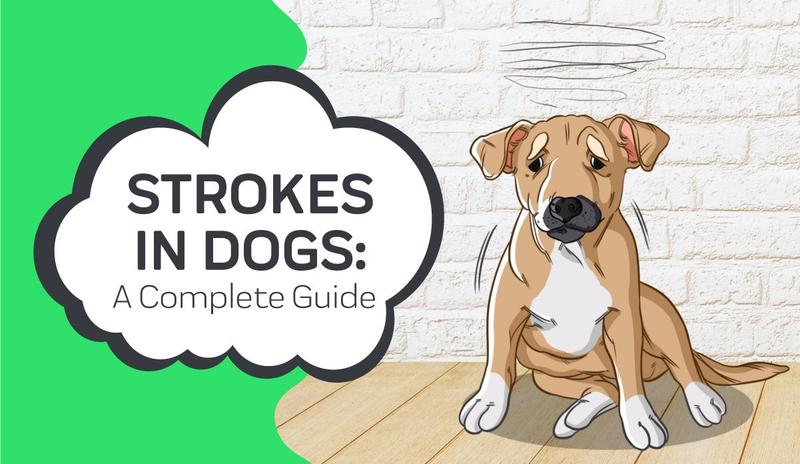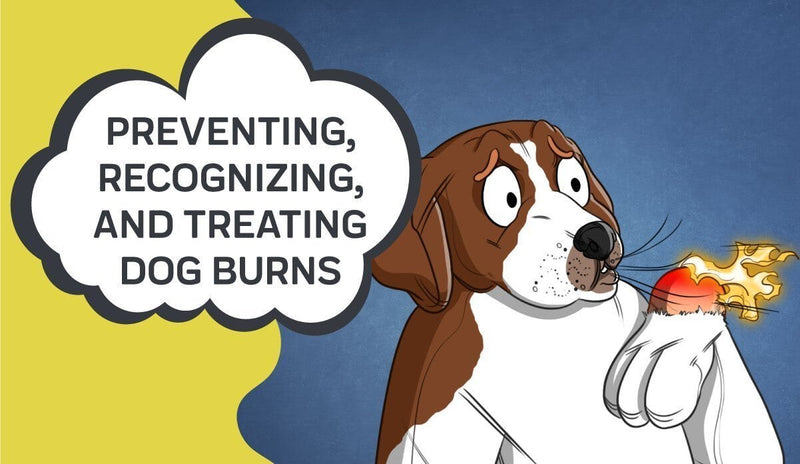
While you may have never thought about the possibility of your pet having a stroke, they're a somewhat common health condition. In this article, we'll explain the underlying causes of strokes, how to diagnose them, and what to do if your dog has been affected by one.
- What Are Strokes In Dogs?
- What Causes Strokes In Dogs?
- The Risk Of Heat Strokes In Dogs
- How To Prevent Heat Strokes In Dogs
- Symptoms Of Strokes In Dogs
- How To Tell The Difference Between Vestibular Disease And Strokes In Dogs
- Treatment For Strokes In Dogs
- How Are Strokes In Dogs Diagnosed?
- Prognosis For Strokes In Dogs
- Conclusion
What Are Strokes In Dogs?
Strokes are a fairly common problem among humans, with thousands of lives being lost to them every year. Until recently, however, it was thought that only a small percentage of cats and dogs were affected by strokes. Now, thanks to advances in technology and new tests being conducted, we realize that strokes in pets are much more common than we used to believe.
A stroke, also known as a cerebrovascular accident, occurs when the blood supply to an animal's brain is lower than it should be. Since the brain is one of the most important, if not the most important, organ in your pet's body, this is a serious and life-threatening issue. The brain requires a constant flow of nutrients and oxygen to function properly, both of which it receives from blood.
There are three types of strokes that can occur in dogs. The first, and most common, is an ischemic stroke, which is caused by an unexpected loss of blood to your dog's brain. The second is a hemorrhagic stroke, which means that there is internal bleeding in your pet's brain, usually caused by a burst blood vessel. And the third kind is a fibrocartilaginous embolism, which occurs when a disk piece of your dog's back breaks free and makes its way into their spinal cord.
What Causes Strokes In Dogs?
 An embolus stroke can be caused by other items moving through your pet's bloodstream, like fatty debris or loose cartilage. If your pet is having a hemorrhagic stroke, then the cause is just the opposite; your dog's blood isn't clotting as it should, and is instead of letting blood bleed into their brain. The brain is dependent on a consistent blood flow more than just about any other organ. It needs blood to deliver nutrients and oxygen, as well as to remove waste. Strokes are caused when anything interrupts or blocks the blood flow to your pet's brain. The most common reasons for blockage are thrombosis and embolus. Thrombosis means that there is blood coagulation blocking the flow of blood in what area of an artery, whereas an embolus means that there is a free-floating blood clot in your pet's artery.
An embolus stroke can be caused by other items moving through your pet's bloodstream, like fatty debris or loose cartilage. If your pet is having a hemorrhagic stroke, then the cause is just the opposite; your dog's blood isn't clotting as it should, and is instead of letting blood bleed into their brain. The brain is dependent on a consistent blood flow more than just about any other organ. It needs blood to deliver nutrients and oxygen, as well as to remove waste. Strokes are caused when anything interrupts or blocks the blood flow to your pet's brain. The most common reasons for blockage are thrombosis and embolus. Thrombosis means that there is blood coagulation blocking the flow of blood in what area of an artery, whereas an embolus means that there is a free-floating blood clot in your pet's artery.
The following are usually behind the cause of strokes in dogs:
- Poison ingestion (rat poison or pesticides)
- Kidney disease
- Brain tumor
- Heart disease
- High blood pressure
- Cushing's disease
- Congenital clogging disease
- Vasculitis
- Parasite infections
- Protein-losing nephropathy
While it's known that these are the primary factors that cause a stroke to occur, it's usually exceedingly difficult to identify the cause of stroke in reality.
The Risk Of Heat Strokes In Dogs

Another kind of stroke that can happen in dogs is a heat stroke. Heat strokes are usually the result of hyperthermia. Not to be confused with hypothermia, hyperthermia means that your pet's body temperature has gone above a safe level. Your dog's temperature should be between 99.8 and 102.8 degrees Fahrenheit. Heat strokes differ from a fever in that they are caused by external factors, like extreme weather, rather than a virus.
Heat strokes generally occur in dogs during late spring and early summer. During this period of time, your pet is still acclimating to the change in weather. So if they spend too much time outside or if the weather changes too quickly, a heat stroke can occur. If you're concerned that your dog may be having a heat stroke, pay close attention to their behavior.
Dogs experiencing a heat stroke will pant frequently, evaporating saliva and sweat. They will also seek cool spots, shade, and water, and will minimize their activity levels as much as possible. Dogs that have dense coats, are young or old, dehydrated, in a poorly ventilated area, or are overweight are more likely to suffer a heat stroke. Heat strokes damage your pet's blood cells, reduce organ performance, and even cause seizures.
How To Prevent Heat Strokes In Dogs
While heat strokes are a serious condition, they're usually pretty easy to spot and prevent! When taking your dog out on a hot day, pay close attention to their behavior, and take any measures you can to ensure that they are cool and comfortable. During the summer, take shorter walks with your pet and limit the amount of time they spend playing outdoors.
If your dog spends a lot of time in the backyard, give them a break from the heat by creating a cooling area. Provide them with plenty of shade, water, and even throw in a cooling pad. They will instinctively go to these things if their body becomes overheated. If you have a long-haired dog, you can wet their hair with cool water before taking them outside, or even get it trimmed during the summer months.
If you suspect that your dog is already having a heat stroke, the first thing you need to do is restabilize their core temperature. You can bring their body temp back down by removing them from the hot environment, placing them in an air-conditioned space,
Symptoms Of Strokes In Dogs
Even though the cause of strokes in dogs can be difficult to determine, it's usually not too hard to know when your dog is experiencing one. The first thing you'll notice in your furry friend is odd behavior and strange movements. If they tilt their head at awkward angles, walk in circles, or easily lose their balance, they could be experiencing a stroke.
Other strange behaviors that dogs experiencing a stroke will show is heading in the opposite direction after being called, eating from only one side of their food bowl, confusion, and loss of bladder control. Keep in mind that the affected organ will be your dog's brain, so the symptoms will primarily be neurological. If the stroke is more severe, your dog could even develop an arrhythmia, causing them to collapse unexpectedly.
More serious symptoms of a stroke include loss of vision, extreme lethargy, loss of bowel control, and vomiting.
Symptoms of strokes in dogs:
- Loss of eyesight
- Difficulty balancing
- Loss of bladder and bowel control
- Head tilting at odd angles
- Walking in circles
- Turning the opposite direction after being called
- Severe loss of control over body movements
- Memory loss
- Lethargy
- Partial paralysis
How To Tell The Difference Between Vestibular Disease And Strokes In Dogs
If you've noticed these symptoms in your dog and attempted to diagnose them yourself, you've likely realized that they overlap with the symptoms of another common health issue in dogs: vestibular disease. It's not uncommon for pet owners to misdiagnose their pets with vestibular disease after they've suffered a stroke. This can be a costly mistake, so regardless of what you believe your pet's problem is, you should always consult a vet for a professional opinion.
Vestibular disease affects your dog's vestibular system, which is responsible for overseeing their balance.
When affected, your dog will go through many of the same symptoms that they would after having a stroke:
- Loss of control over body movements
- Loss of balance
- Rapid and involuntary eye movements
- Difficulty standing and walking
- Disorientation and confusion
Vestibular disease in dogs can be caused by a variety of factors. These causes can range from severe health conditions to minor inconveniences. For instance, one potential cause of vestibular disease is an ear infection, while another is brain tumors. Older dogs are typically at a greater risk for developing vestibular disease.
Treatment For Strokes In Dogs
The unfortunate reality about strokes in dogs is that once they occur, there isn't much that can be done to treat the effects. Damage to the brain is usually permanent, so your vet will likely be left with little to no options for resolving the damage. The closest there is to treatment for dogs with strokes is to diagnose the cause and take steps to make sure it doesn't happen again.
On a more positive note, the bright side is that strokes generally don't have a lasting effect on your pet's quality of life. It is possible for a stroke to cause severe and permanent damage, but most of the time they return back to their old self within a few days. The best thing you can do for your pet after they've suffered from a stroke is to show them lots of love, support, and attention.
If your dog loses an important bodily function after a stroke, like their vision or bladder control, you'll need to take extra steps to keep their quality of life as high as possible.
How Are Strokes In Dogs Diagnosed?
If you suspect that your dog has had a stroke, check their gums and inner eyelids. They will likely be a dark red color, indicating that they are experiencing a lack of oxygen. Either way, you should take them to a vet as quickly as possible. Your vet will use either a CAT scan or an MRI to determine if your dog has had a stroke, or if there is another cause under the surface.
Cardiac issues typically exhibit similar symptoms to a stroke, so your vet will most likely check your pet's heart to make sure it's functioning as it should. This could include a cardiogram, x-ray, and maybe even a cardiac ultrasound.
After your vet determines that their heart is functioning as it's supposed to, they'll likely move on to examine your pet's brain. Strokes can usually be identified with an MRI or CAT scan. Your vet will also do tests, like urinalysis and bloodwork, to try to figure out what caused the stroke.
Prognosis For Strokes In Dogs
Even though there is no clear treatment or guarantee of diagnosing the cause, most dogs that suffer a stroke return to their normal lives pretty quickly. After just a few weeks your dog should be back to their normal selves! And if your vet is able to diagnose the cause of the stroke, then your pet has little to worry about in terms of living a full and happy life.
It is possible that some dogs will experience permanent damage to their bodily functions, which will require some special care. The more time that passes after your dog has survived a stroke, the higher their chances of leading a normal life are.
While your dog is recovering from their stroke, they will most likely need help going through the motions of their normal routines. Helping them to their food, eat, and go to the bathroom might be required.
Conclusion
While a stroke is an unpredictable and frightening issue for you and your dog, the effects are usually short-lived and easy to manage. Even in severe cases, where your pet develops a disability, there are plenty of options for making their life just as comfortable and pleasant as before.
Sources:
Hyperthermia and Heatstroke in the CanineWhat is a Stroke?
Stroke in Dogs














